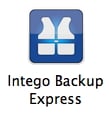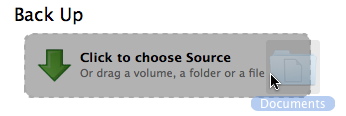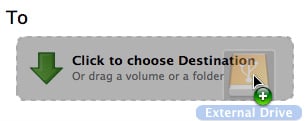Welcome to Intego Backup Express
About Intego Backup Express
Intego Backup Express is a powerful backup program for Mac OS X, protecting you from data loss by making copies of your documents, photos, videos and music files onto external media.
Intego Backup Express can back up files from your home folder, or disks or volumes for which you have permissions, to most media, including:
- Partitions or volumes on your hard drive
- External hard drives
- Removable media (such as USB key drives)
- Optical media (such as recordable CDs or DVDs)
- Network volumes
- AirPort disks (hard disks connected to Apple's AirPort Extreme or Time Capsule base station)
- An iDisk (available with Apple's MobileMe service)
- An iPod (if it offers hard disk mode)
- Disk images
Backup Express can back files up to any of the above, as long as you have the appropriate permissions.
Backup Express can also synchronize data between two computers (such as a desktop Mac and a MacBook or MacBook Pro). And, of course, it restores files to your computer as easily as it backs them up.
At its simplest, backing up files with Backup Express requires dragging and dropping a couple of folders and clicking the Backup button. For more complex tasks, Backup Express's advanced mode lets you create backup scripts that perform multiple actions, and that can run on predetermined schedules.
Getting Started with Intego Backup Express
After you download Intego Backup Express from the Mac App Store, the program is installed in your Applications folder, and its icon is added to your Dock. You can launch the program by clicking the Dock icon or double-clicking the program's icon in your Applications folder.
Your First Backup
Making your first backup is simple. First, launch Intego Backup Express; there are two ways to do this:
Navigate to your Applications folder in the Finder, then, double-click the Backup Express icon.

Or, click the Backup Express icon in your Dock, if you have left it there.
If you haven't created any scripts already in a previous version of Backup Express, the first time you launch the program it displays a window with two default scripts, a backup and a synchronization script, neither of which have source, destination or options defined.
To create a first backup, click the "untitled backup script" to select it. Next, add your source. To do this, drag its folder - that is, the one containing files you want to back up - from the Finder to the area labeled Click to choose Source. (You can also click in that area and navigate to the source folder through Mac OS X's file selection window.)

Do the same for the backup's destination.

The window will now show which folder you intend to back up, and where the files are going.

Then click the Back Up button, the one that looks like a "Play" button.

Backup Express will back up all the files that you have permission to copy from the source folder to the destination folder or volume.
That's it! You now have a spare copy of all files in the source, ready in case any of the original files disappear.
But Backup Express does much more than the simple backup described here; the next chapter details all the options that give it the power to satisfy everyone's backup needs, from the single-Mac home user to the corporate administrator of thousands of computers. Read the next section of this manual to learn more about backups and protecting your files.
About Backups
Backup Express performs the following operations:
A backup copies specific files and folders from one location to another. The location that contains files at the beginning of the process is called the source; the one receiving the copied files is the destination. To keep the backup files safe, the destination files should be stored and never modified, and should be on a different storage device from the source. For example, you might back up files from your MacBook Pro onto an external hard disk that you keep at home: then, if the MacBook Pro gets lost, stolen or damaged, you still have copies of your files on the hard disk.
One common backup strategy is to make a copy of all your files when you first run Backup Express. Then on each subsequent run, you direct the program to copy only those files that have changed since the last backup. This is called an "incremental" backup. (Don't worry - Backup Express makes these easy.)
Restoring is the opposite of backing up, and is usually performed when source files have disappeared or become damaged (or when you've accidentally deleted some). You copy files from the destination disk back to the original source. (In our example above, these files would go from the external hard drive to your MacBook Pro.) Of course, these files will only be current as of the last time you performed a backup: if you've modified those files since then, that subsequent work will be lost - hence the need to make regular backups.
Synchronization twins a source's contents so both the source and destination are identical. The first time you run a synchronization, Backup Express may copy many files to ensure that both the source and destination contain the same elements. But after that, only those files that are changed on one side are copied to the other side, and, by default, items removed from one side are deleted from the other. Since you may update some files on, say, your desktop Mac and others on your laptop, a synchronization can keep both of these Macs up to date with the latest versions of each file. Changing file A on your desktop Mac and file B on your laptop means that, when synchronizing the two Macs, file A will be copied to the laptop and file B to the desktop Mac. The result is that the source and destination are always maintained as exact duplicates of each other.
Backup Decisions
Before you implement your backup plan, determine four things:
- Source: Which files will I back up?
- Destination: Where will these backup files be stored?
- Schedule: When and how often will I perform these backups?
- Archives: How long will I keep backup files?
If you can't make up your mind right away, don't worry: you can have several backup strategies running concurrently. For example, you might decide to make daily backups of important business files to DVDs that are then delivered to an offsite location (such as a safe-deposit box) once a week. On the other hand, perhaps you consider photos and videos of office renovations much less important, so you back them up only once a month to a server in the office.
Two criteria help you make decisions regarding which source files to backup: the files' importance, and the amount of space available for backup. If, for example, your home folder (the one with your name on it) on MacBook Pro contains 100 GB of files, and you have a 1 TB external hard drive available for backups, your decision is easy: back up everything, since there's no reason to save a few gigabytes when you have so many to spare.
If you're short on space, your decisions are more complicated. Which files will cause the most inconvenience if lost? Which are irreplaceable? For most people, personal and business documents come first; think of all your family photos and videos, and any music you've bought by download, as well as any tax records, accounting software files, receipts in electronic format, and your e-mail. On Mac OS X, most of your personal documents are stored in the Documents folder of your home folder. But if you have room, don't forget the Pictures, Movies, and Music folders! These are also in your home folder, next to your Documents folder.
The destination for your backups could be on the same device as the source, although we recommend you use an external device for all backups except the most casual (and insecure). The trouble with having the source and destination on the same device is that a problem with that device (such as a hard drive crash) could easily destroy both your originals and your backups, leaving you with nothing.
Instead, we recommend you make backups to another device, such as a CD, DVD, or external hard drive. (Note that high-capacity external hard drives are relatively inexpensive.) If you have a MobileMe subscription, you can use Backup Express to back up selected folders to your iDisk. To save space (and copying time over a network), Backup Express can make incremental backups that replace only those files that have changed or been created since the last backup.
We recommend you take the total size of your source files and budget at least twice as much space on your destination disk. This ensures that there is enough room for the many files that change from one backup to the next.
When you use removable media (such as CDs or DVDs), Backup Express will let your backups span multiple discs, asking you to insert a new disc as each one fills up. In this way you have a (theoretically) infinitely big destination: all you need is more discs! However, such media can become inconvenient for very large backups, as you'd have to attend to the backup and switch out disks every few minutes.
Your backup schedule depends on how often you change the original files. Ask yourself this: how long will it take to recreate changes made to lost files? For example, let's say you start working intensively on a file at 9 am. If you lose it due to a crash or power outage at noon, you'll probably need three hours to restore the file - if that's even possible.
To ensure that you don't lose such data, you should regularly back up your files. For critical data, a backup of working files to external media (or a network location) every few hours is wise, and for professional documents, you may want to run hourly backups. Then, complete daily or weekly backups provide additional protection to cover all files, whether you have worked on them or not.
Again, scheduling decisions will depend on the amount of space available on your destination device. If you have plenty of space compared to the total size of your source files, and are able to perform backups conveniently, there's no reason not to do them every day. Consider how long you'll want to keep archives of your backups. A financial-services company might be required by law to retain computer data for several years: such a company would want to ensure that it always has a definitive copy of each file stored away in case auditors come around. However, it probably won't need to access those old files frequently, or at all: therefore, it would probably store them in a compressed format (to save space), at an offsite location.
On the other hand, home users might want to make backups only to ensure that they can recover the most recent versions of their files, not caring about older versions. For them, the best solution might be to back up their Macs to external drives, automatically discarding old versions as they go.
In any case, you should develop a backup strategy that corresponds to the way you work-and perform regular backups.
The next section of the manual tells you how you can prepare your backup and synchronization scripts using the many options available in Backup Express.